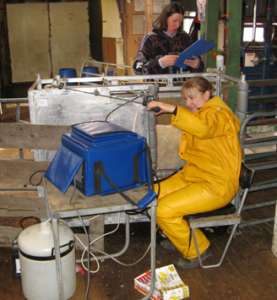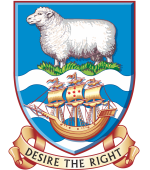Sheep Ultrasound Pregnancy Diagnosis
Since 2002 the Department of Agriculture has been able to offer a Ewe Ultrasound Pregnancy Diagnosis (scanning) to farmers.
Worldwide, scanning is used as an important management tool. It allows producers to relatively accurately predict lambing percentage. These results are the n used to alter or fine-tune management practises relating to nutrition, health and pasture use. This practise has therefore fitted neatly into the Farm Improvement Programme.
n used to alter or fine-tune management practises relating to nutrition, health and pasture use. This practise has therefore fitted neatly into the Farm Improvement Programme.
The scanning information can also be utilised as a financial forecasting tool: i.e. cash flow budgets, enabling better estimates of income and expenses.
The benefits of determining if a ewe is pregnant or not include:
- Being able to plan and budget for feeding/pasture – dry ewes can be run as wethers, ewes with multiple lambs can be moved to best pastures and fed supplements as required.
- Being able to see what your conception rates are compared to lambs born or lambs marked. Marked differences in conception to weaning rate can be investigated.
- Being able to see if any particular ewes are consistently not producing a lamb, they should be removed from the flock.
- Being able to estimate conception rates lambing percentage to enable you to forecast meat or wool income.
- Being able to body condition score pregnant ewes and feed those that need extra accordingly, or cull them if they are never going to successfully raise a lamb.
Facilities needed:
- Pens and race – a temporary race made out of pens/gates is fine. For optimum flow of sheep have the panels before the scanning crate solid or covered so the sheep cannot see the scanner.
- A continuous supply of hot and cold water - access to a working kettle is fine for the hot water supply.
- A reliable power source.
- Sufficient workforce – 1 person to work the crate/drafting gates, 1-2 people to push sheep up the race and fill pens and 1 person to write tag numbers etc. if required.
- Ideally scanning would occur in a shed with easy access to power and water but scanning in the field is possible with prior arrangement
When to scan:
- Naturally mated ewes
- A short joining period of 34 days (2 cycles) is advisable. It is important (for many reasons) that rams are taken OFF the ewes. Scanning is optimal from 42-45 days from when the ram is taken off. Added benefits of a short joining period are:
- A short and concise lambing period
- A shorter time period needed to spend shepherding
- All lambs will be nearer in age for weaning/lamb marking
- A short joining period of 34 days (2 cycles) is advisable. It is important (for many reasons) that rams are taken OFF the ewes. Scanning is optimal from 42-45 days from when the ram is taken off. Added benefits of a short joining period are:
Longer joining periods may mean that 2 scanning sessions are needed to accurately detect all pregnancies which will obviously be more costly and time consuming
- AI ewes and Cover Rams:
- Any ewes that don’t conceive at AI should cycle and be fertile again 17 days after the AI attempt, therefore to ensure a concise lambing period put cover rams out 2 weeks after the AI day for 35 days (2 cycles)
- It is important to have raddle or harnesses on your rams. Marked ewes can be assumed to be cycling and not to have conceived via AI so if they are scanned pregnant it can be noted that this is probably to cover ram that the AI.
- Scanning should occur between 70-90 days after the AI date.
Other information:
- Ewes need to be off food and water overnight/twelve hours before scanning. Accurate scanning with a full rumen is both difficult and hard work.
- Having the ewes half bellied makes the job much quicker and easier.
- Please contact in good time, with all relevant dates and information so logistics can be arranged.
HOW TO BOOK YOUR SCANNING:
This email address is being protected from spambots. You need JavaScript enabled to view it.
Please let us know the dates when the rams went in and off and how many ewes there are to scan.

